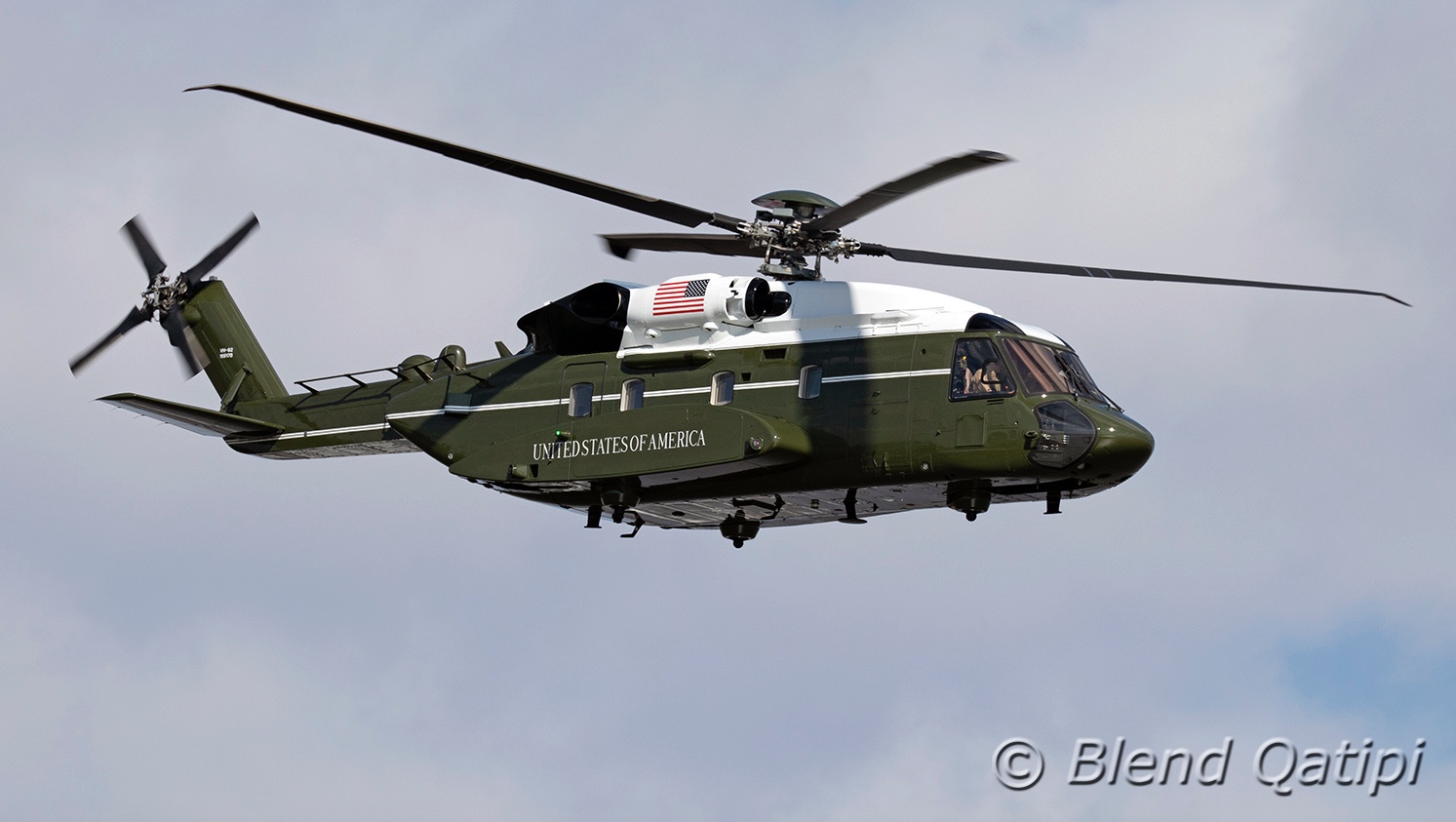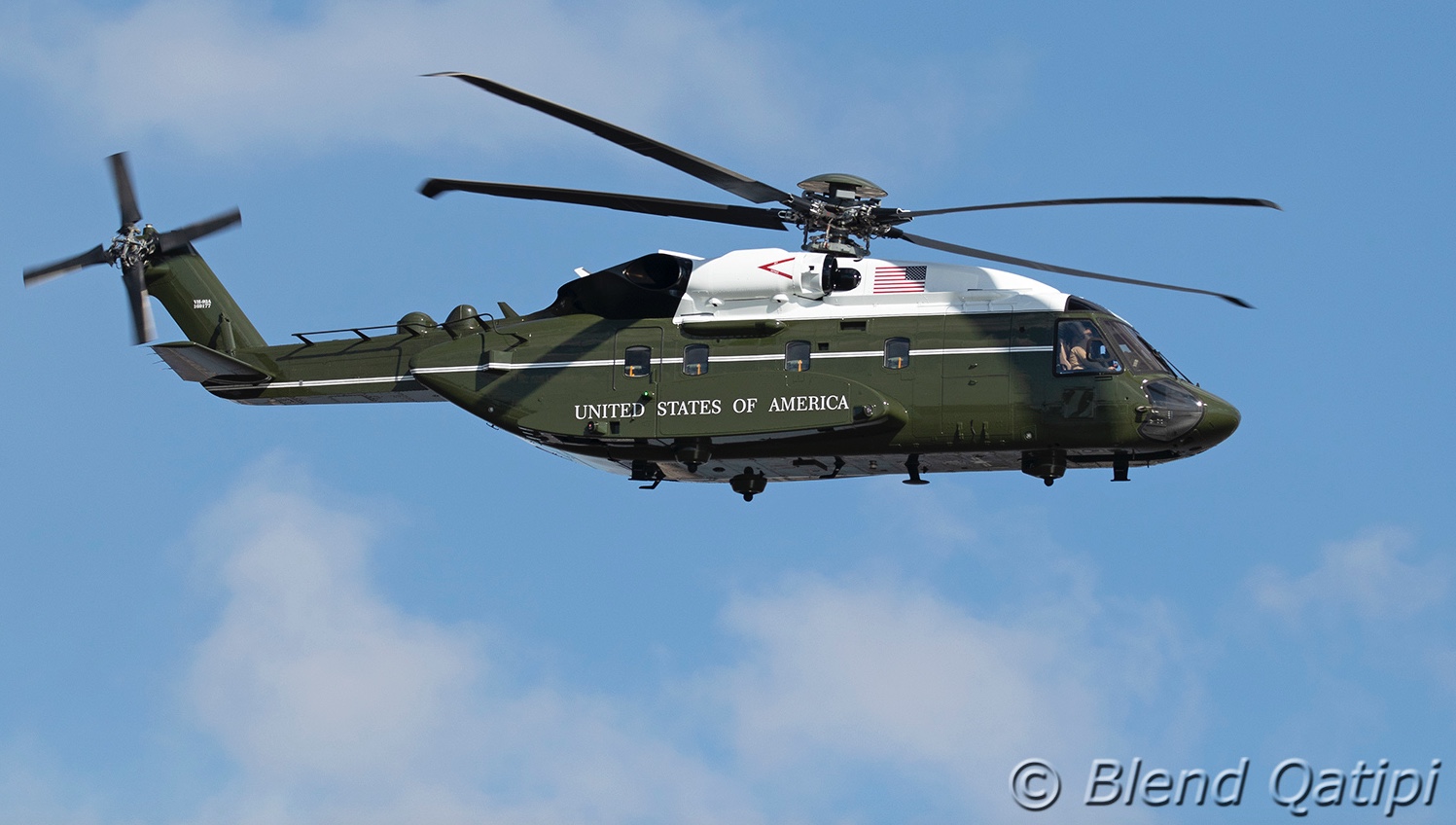It’s amazing to think that the helicopters that will finally replace the VH-3D and VH-60N in the Marine One role will start flying in conjunction with that mission operationally by the end of this year. By 2023, the entire fleet of 11 VH-3Ds and 8 VH-60Ns will be replaced by 23 VH-92s, ending a long run by both helicopters in the prestigious role and especially by the Sea King based VH-3D.
With its in-service date rapidly approaching and no major issues holding it back—at least according to official documentation—it makes sense that intense testing and training is underway around the Washington, D.C. area. This provided a great opportunity to aviation photographer Blend Qatipi who snapped beautiful photos of the soon to be Presidential helos as they flew over Potomac River. The photo of two in formation is the first like it we have seen.
The photos give us amazingly clear views of the latest VH-92A configuration, which includes one major new addition. A new satellite communications dome has been added to the upper tail-boom area ahead of the one that already existed. This installation is likely in line with what we have seen on the rest of the Presidential and National Command Authority’s aircraft, among others in the U.S. military. In addition to older MILSTAR and UHF satellites communications, new wide-band global SATCOM capabilities are being added to give aircraft super-secure high-speed connectivity virtually anywhere in the world. You can read all about this system and the aircraft it is showing up on in this past piece of ours.
It’s also worth noting that we have seen other major satellite connectivity improvements to Presidential transport capabilities recently, including a massive new command and communications vehicle that sports a big SATCOM array being added to the Secret Service’s motorcade fleet.

An array of other antennas also populates the aircraft’s skin. These include a high-frequency railing-like array on the tail boom for long-range radio communications, as well as a platter array on the bottom of the aircraft usually associated with air-to-ground mobile phone network calling capabilities.
Beyond that, all the systems you would expect on Marine One are present. These include laser-based directional infrared countermeasures, which you can read all about in this past piece of ours about the rapidly evolving VH-92. The small missile launch detectors that cue this system and the helicopter’s overall self-protection suite can be seen mounted on the helicopters sponsons just below the “United States Of America” title.

You can also see a discreet countermeasures dispenser bucket mounted near the rear of the fuselage. These can be filled with expendable decoys—flares and possibly chaff—when operating in especially high-threat areas.
When the aircraft becoming operational, they will be located at HMX-1’s base in Quantico, Virginia and will also stand alert, ready to whisk the President away to safety at a moment’s notice, at Naval Support Facility Ancostia in Washington, D.C. With this in mind, testing and training around the D.C. area is key. Most notably, we were first to report on the VH-92 undergoing landing and takeoff testing on the White House’s South Lawn fairly recently. This test event also resulted in spectacular images. Also, NAS Patuxent River, the Navy’s primary aircraft test base where the VH-92 program is located, is just 50 miles away from Washington, D.C.
So, with all this in mind, suffice it to say that we will be seeing a lot more of the VH-92s in the area as the type dashes towards initial operating capability (IOC). Eventually the type will become a fixture of the area skyline, just like other Marine One helicopters that came before it. Considering Marine One helicopters always operate in pairs for Presidential airlift missions—one acting as a decoy in a constantly morphing aerial shell-game—the banner shot on this page will become an iconic visual in the years to come.
Author’s note: A huge thanks to Blend Qatipi for sharing is wonderful photos with us. Make sure to check out his photos over on Flickr, he really has the Washington, D.C. area covered when it comes to taking pics of all the cool airplanes that come and go from the region.
Update: 10:45pm PDT—
Some of our sharp-eyed readers pointed out that the two paint schemes differ slightly and they are very much right. The front helicopter has the American flag on the engine cowling and the white paint moves around the forward part of the engine exhaust. The United States Of America title is also smaller in size on the sponson. The rear aircraft has the traditional turbine intake warning chevron in red where the flag was on the lead helicopter and the flag has been moved to in front of the intake. Black paint totally surrounds the engine exhaust, too. The United States Of America title is also larger and fills out more of the sponson’s flat side area.
I would guess that the rear aircraft’s paint job is more representative of the final scheme, but we don’t know for sure. The operational aircraft all have to match in every way as there can be no way to tell them apart visually or the decoy concept of operations would be degraded or even useless.
Contact the author: Tyler@thedrive.com
